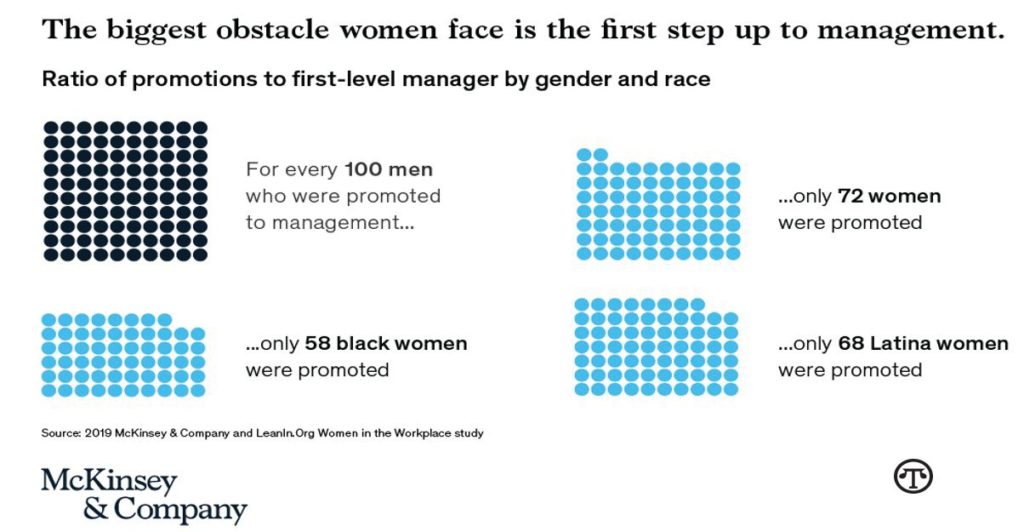The State Of Gender Parity in the COVID Crisis: A Greater Need For Continued Diligence

by Laurie Cooke, PGDip, RPh, CAE
(NAPSI)—The groundswell of energy around gender parity and equity—in healthcare and in the larger world—has been palpable. Attention has reached an even greater fever pitch in light of COVID’s affect on women in the workforce. As Melinda Gates noted last year when announcing her $1 billion donation to support gender equality, it feels as though a window of opportunity has opened.
The recent Women in the Workplace study from LeanIn.org and McKinsey & Company reflects this. The study shows that more companies are embracing best practices, deepening commitments and holding senior leaders accountable for progress. And the numbers are moving—with women’s C-suite representation rising from 17 percent in 2015 to 21 percent in 2019.
The numbers also reveal, however, that the COVID-19 pandemic has had a particularly damaging affect on women’s careers. Women’s jobs are 1.8 times more vulnerable to the crisis than are men’s. Women make up 39 percent of employment but account for 54 percent of job losses. One reason is the increasing burden of unpaid care, which disproportionately falls on women, particularly mothers, senior-level women and Black women.
As a result, 1 in 4 women are contemplating what many would have considered unthinkable a year ago: downshifting their careers or leaving the workforce. For the first time, women are leaving the workforce at higher rates than men and that can be critical for corporate America. Companies risk losing women in leadership—and future women leaders—and unwinding years of painstaking progress toward gender diversity. But it also represents an opportunity. If companies invest in a more flexible, empathetic workplace they can retain employees and create more opportunities for their women workers and themselves to succeed. Research shows that when women are well represented at the top, companies are 50 percent more likely to outperform their peers.
Fixing the problem needs a focus on three key areas:
•The “broken rung” at the start of the corporate management ladder. The Women in the Workplace report shows that just 72 women for every 100 men are hired and promoted to the first level of management. This threatens parity at each subsequent level—and must be fixed to create a strong female talent pipeline for the future. In healthcare specifically, we must also work on movement at the top.
•Progress for all women. Progress has not been equally shared. For example, while one in five C-suite leaders is female, just one in 25 is a woman of color. Black women and Latinas, in particular, are more likely to be held back by the broken rung and to fare worse in their experiences overall. We must broaden inclusivity.
•Rigorously prioritizing initiatives based on contextual data. For example, data from a 2019 HBA and Aon survey shows that the gender pay gap is widest in research and development positions and in smaller organizations, with the largest disparity in bonuses given. In addition, the Women in the Workplace study shows that while the length of paternity leave has increased from four to seven weeks over the past three years, the length of maternity leave has remained stagnant at 10 weeks. We must continue sharing data and adjust our priorities and policies.
How can we keep up our energy for the work still to come?
A combination of agility and collaboration can help organizations remain focused, passionate and effective for the long haul. By regularly measuring outcomes, reassessing priorities and testing new approaches, we can let go of what’s not working, celebrate what is and refine along the way—preventing stagnation and encouraging creativity. For example, with 16 companies joining forces to make up HBA’s Gender Parity Collaborative, the healthcare industry is working to systemically move women further, faster and serves as a model for others to follow. We encourage companies to work together to capitalize on this window of opportunity—so we can finally achieve parity for all.
For more information on the Women in the Workplace survey, or the Healthcare Businesswomen’s Association, visit genderparity.hbanet.org.
• Ms. Cooke is President and CEO, Healthcare Businesswomen’s Association (HBA), an industry champion of the Women in the Workplace study.
